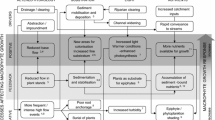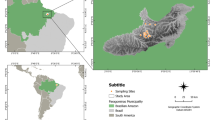Abstract
The species diversity of macrophytes and their abundance in middle-sized streams of Latvia were investigated. On the basis of environmental factors (stream width, water depth, substrate type, shading, and flow velocity), five major groups of streams were distinguished representing mutually exclusive macrophyte communities—(1) fast flowing streams on gravel substrates, (2) slow flowing streams on gravel substrates, (3) fast flowing streams on sandy substrates, (4) slow flowing streams on sandy substrates, and (5) streams with soft, silty substrates. A total of 48 macrophyte taxa were found in 72 surveyed sites. The most frequent species in the investigated streams were Sparganium emersum, S. erectum s.l., Nuphar lutea, Veronica beccabunga, as well as the invasive alien Elodea canadensis. The species richness ranged from 2 to 22 per site, and Shannon diversity index varied from 0.61 to 2.88. The highest species richness (22) was found in slow flowing streams with gravel substrates. Poor macrophyte composition was characteristic for fast flowing streams on sandy substrates.


Similar content being viewed by others
References
Abolina, A., 2001. Latvijas sūnu saraksts. Latvijas Veģetācija 3: 47–87 (In Latvian).
Abou-Handman, H., J. Haury, J. P. Hebrard, S. Dandelot & A. Cazaubon, 2005. Macrophytic communities inhabiting the Huveaune (South-East France), a river subject to natural and anthrophic disturbances. Hydrobiologia 551: 161–170.
Baatrup-Pedersen, A. & T. Riis, 1999. Macrophyte diversity and composition in relation to substratum characteristics in regulated and unregulated Danish streams. Freshwater Biology 42: 375–385.
Baatrup-Pedersen, A., G. Springe, T. Riis, S. E. Larsen, K. Sand-Jensen & L. M. Kjellerup Larsen, 2008. The search for reference conditions for stream vegetation in northern Europe. Freshwater Biology 53(9): 1890–1901.
Chambers, P. A., E. E. Prepas, H. R. Hamilton & M. L. Bothwell, 1991. Current velocity and its effect on aquatic macrophytes in flowing waters. Ecological Applications 1: 249–257.
Dawson, F. H., 2002. Guidance for the field assessment of macrophytes of rivers within the STAR Project [available on internet at http://www.eu-star.at/frameset.htm].
Demars, B. O. L. & D. M. Harper, 1998. The aquatic macrophytes of an English lowland river system: assessing response to nutrient enrichment. Hydrobiologia 384: 75–88.
European Commission, 2000. Directive 2000/60/EC. Establishing a framework for community action in the field of water policy. European Commission PE-CONS 3639/1/100 Rev 1, Luxembourg.
Furse, M., D. Hering, O. Moog, P. Verdonschot, R. Johnson, K. Brabec, K. Gritzalis, A. Buffagni, P. Pinto, N. Friberg, J. Murray-Bligh, J. Kokes, R. Alber, P. Usseglio-Polatera, P. Haase, R. Sweeting, B. Bis, K. Szoszkiewicz, H. Soszka, G. Springe, F. Sporka & I. Krno, 2006. The STAR project: context, objectives and approaches. Hydrobiologia 566: 3–29.
Gavrilova, G. & V. Sulcs, 1999. Flora of Latvian vascular plants. List of taxa. Institute of Biology of University of Latvia, Laboratory of Botany, Riga: 136.
Haslam, S. M., 2006. River Plants. The macrophytic vegetation of watercourses. 2nd revised ed. 438 pp.
Holmes, N. T. H., J. R. Newman, S. Chadd, K. J. Rouen, L. Saint & F. H. Dawson, 1999. Mean Trophic Rank: A Users Manual. R&D Technical Report E38. Environment Agency of England & Wales, Bristol, UK.
Klavins, M., V. Rodinov, I. Kokorite & I. Klavina, 1999. Chemical composition of surface waters of Latvia and runoff of dissolved substances from the territory of Latvia. Vatten 55: 97–108.
Madsen, J. D., P. A. Chambers, W. F. James, E. W. Koch & D. F. Westlake, 2001. The interaction between water movement, sediment dynamics and submersed macrophytes. Hydrobiologia 444: 71–84.
McCune, B. & M. J. Mefford, 1999. PC-ORD. Multivariate Analyses of Ecological Data. Version 4.17. MjM Software, Gleneden Beach, Oregon USA.
Preston, C. D. & J. M. Croft, 2001. Aquatic Plants in Britain and Ireland. Harley Books, Martins, Great Horkesley, Colchester, England: 356.
Riis, T., 2008. Dispersal and colonisation of plants in lowland streams: success rates and bottlenecks. Hydrobiologia 596: 341–351.
Riis, T. & B. J. F. Biggs, 2003. Hydrologic and hydraulic control of macrophyte establishment and performance in streams. Limnology and Oceanography 48(4): 1488–1497.
Riis, T., K. Sand-Jensen & O. Vestergaard, 2000. Plant communities in lowland Danish streams: species composition and environmental factors. Aquatic Botany 66: 255–272.
Riis, T., A. M. Suren, B. Clausen & K. Sand-Jensen, 2008. Vegetation and flow regime in lowland streams. Freshwater Biology 53: 1531–1543.
Schaumburg, J., C. Schranz, J. Foerster, A. Gutowski, G. Hofmann, P. Meilinger, S. Schneider & U. Schmedtje, 2004. Ecological classification of macrophytes and phytobenthos for rivers in Germany according to the Water Framework Directive. Limnologica 34: 283–301.
SPSS Inc., 2000. Systat for Windows, Version 10, SPSS Inc, Chicago, IL, USA.
Acknowledgments
The author was grateful to all his colleagues and friends for help in field surveys, especially to Agnese Priede, Gunta Spriņģe, and Egita Zviedre for advices and help. He also thanks an anonymous reviewer for highly useful comments. This study was financially supported by European Social Fund.
Author information
Authors and Affiliations
Corresponding author
Additional information
Guest editors: A. Pieterse, S. Hellsten, J. Newman, J. Caffrey, F. Ecke, T. Ferreira, B. Gopal, J. Haury, G. Janauer, T. Kairesalo, A. Kanninen, K. Karttunen, J. Sarvala, K. Szoszkiewicz, H. Toivonen, L. Triest, P. Uotila, N. Willby / Aquatic Invasions and Relation to Environmental Changes: Proceedings of the 12th International Symposium on Aquatic Weeds, European Weed Research Society
Rights and permissions
About this article
Cite this article
Grinberga, L. Environmental factors influencing the species diversity of macrophytes in middle-sized streams in Latvia. Hydrobiologia 656, 233–241 (2010). https://doi.org/10.1007/s10750-010-0432-3
Published:
Issue Date:
DOI: https://doi.org/10.1007/s10750-010-0432-3




